Ask any triathlete and they will tell you…….yes and…..no
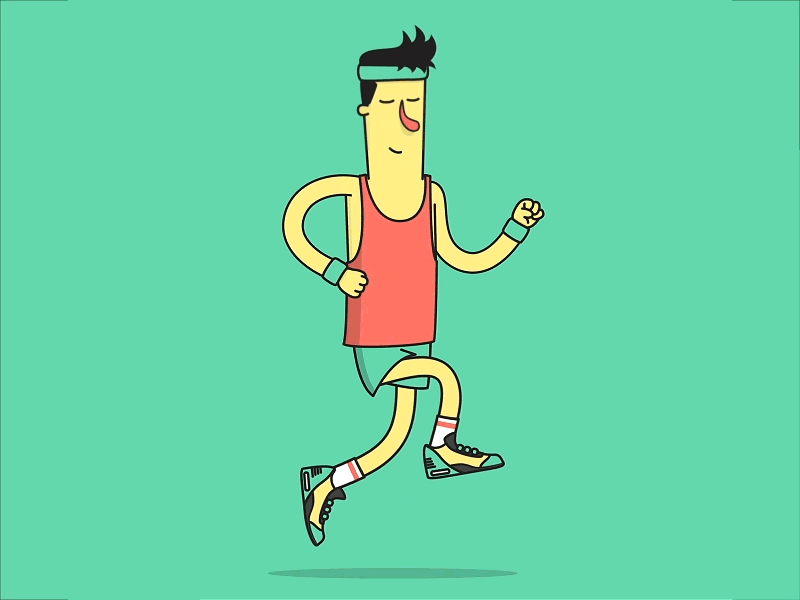
A regular coached cyclist, with cycling goals…..asked me how much will running harm his cycling (if at all) and can both be done successfully? He wanted to add running but he was worried it might have a negative effect. In short is running a good idea if you have cycling goals?
I started by doing a survey. I surveyed our viewers this week and 40% of you said you never run, only bike!
However 42% of you do both successfully! so its about even. Today let’s look at the evidence for combining activities vs sticking with cycling alone.
.
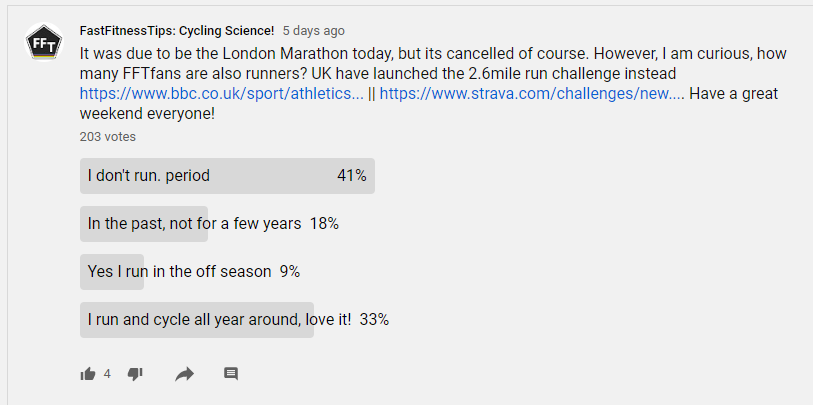
Strava insights says single-sport athletes have shown a definite decline, with cycling-only users decreasing from 67.9 per cent in 2015 to 47.2 per cent in 2019. Popular 2nd sports for cyclists include: walking up by 67 per cent, yoga by 74 per cent, and weight training up by a staggering 289 per cent.
QUICK ANSWER TO ADDING RUNNING
At face value the answer is really simple, millions of triathletes and duathletes prove that it is possible to cycling and run in one event, in the same day, in the same week and in one season successfully. Indeed the running times of pro triathletes, running off the bike in 5k,10k, HM, Marathon are stunning.
For example Lionel Sanders did an Iron man leg marathon in 2:42:31 and the entire race in 7:44:29 in 2016. Matt Hanson completed one in 2:34:39 (2018) and Chrissie Wellington did the Challenge Roth in 2:44:35. I am going to make a guess that these are only 8%-13% behind their solo marathon PR/PY times.
However, lets not pretend this is easy. Check out this story (link). Concentrating on one activity nearly always improves that one activity relative to others. Lets say you wanted to take up archery. You would progress faster concentrating on archery than starting archery and piano at the same time and dividing your time 50:50. That’s the training principle of specialization. BUT you can take this too far and become a one-trick pony way way too early at the expense of other experiences

So lets look at why running AND cycling is hard. Obviously running a marathon is huge challenge, never mind running after a 90km bike ride at tempo pace. This is crazy hard and these time a testament to lifelong training.
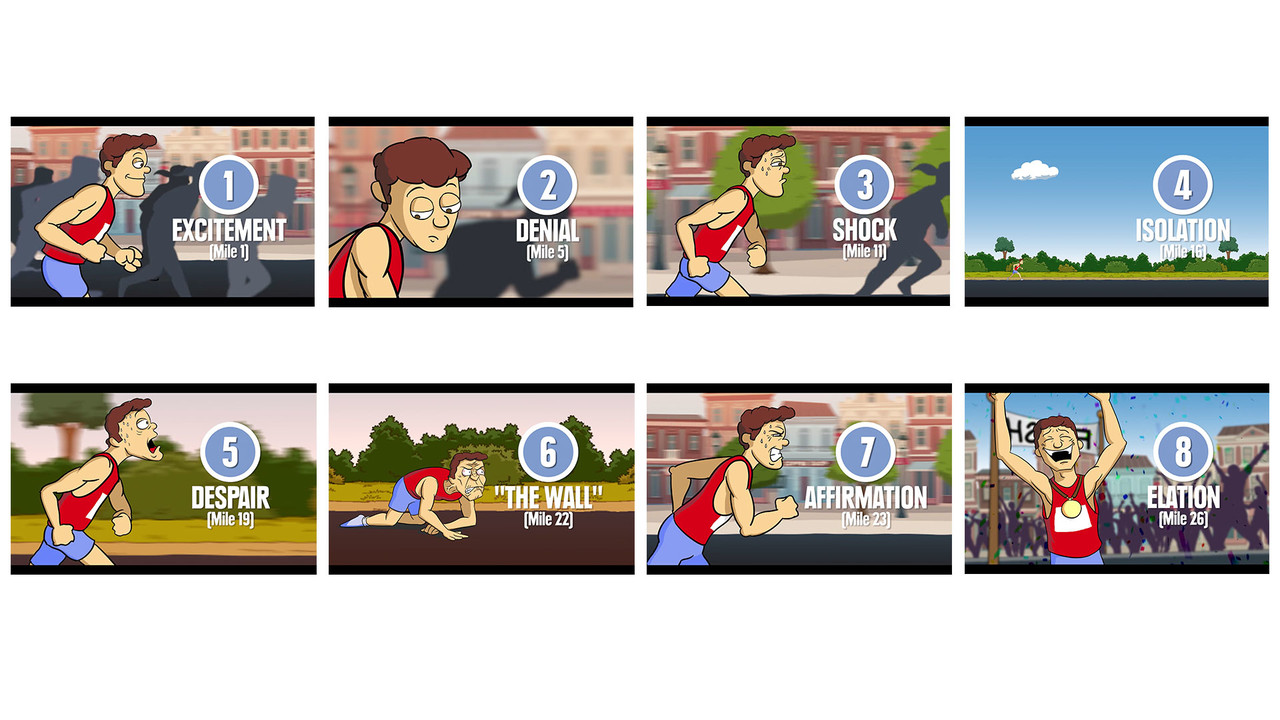
In fact if you have never tried to run after a bike ride, try it for fun tomorrow. You will get a serious shock as your worn out cycling muscles tries to stop your brain telling your weak-as-a-kitten running muscles to spur into action!
DO THE MUSCLE GROUPS DIFFER?
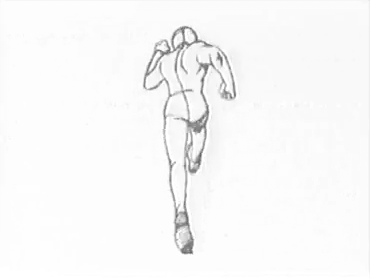
Although the same muscles are basically involved in running and cycling, they are not used in the same way at the same intensity or the same range of movement. Consider the force on the calf when running, compared with cycling. The ground reaction force is dramatic

Quads and Hamstrings = Involved in both running and cycling
Both running and cycling use the quadriceps and hamstrings. Your quads lift the leg for a stride when running or pedal rotation when cycling, while your hamstrings pull the leg back down. When you are running, your thigh muscles are the primary muscles. When you’re cycling, the muscles are important to the mechanics of pedaling, but, when you pedal properly, they don’t generate the main power source for the pedal rotation.
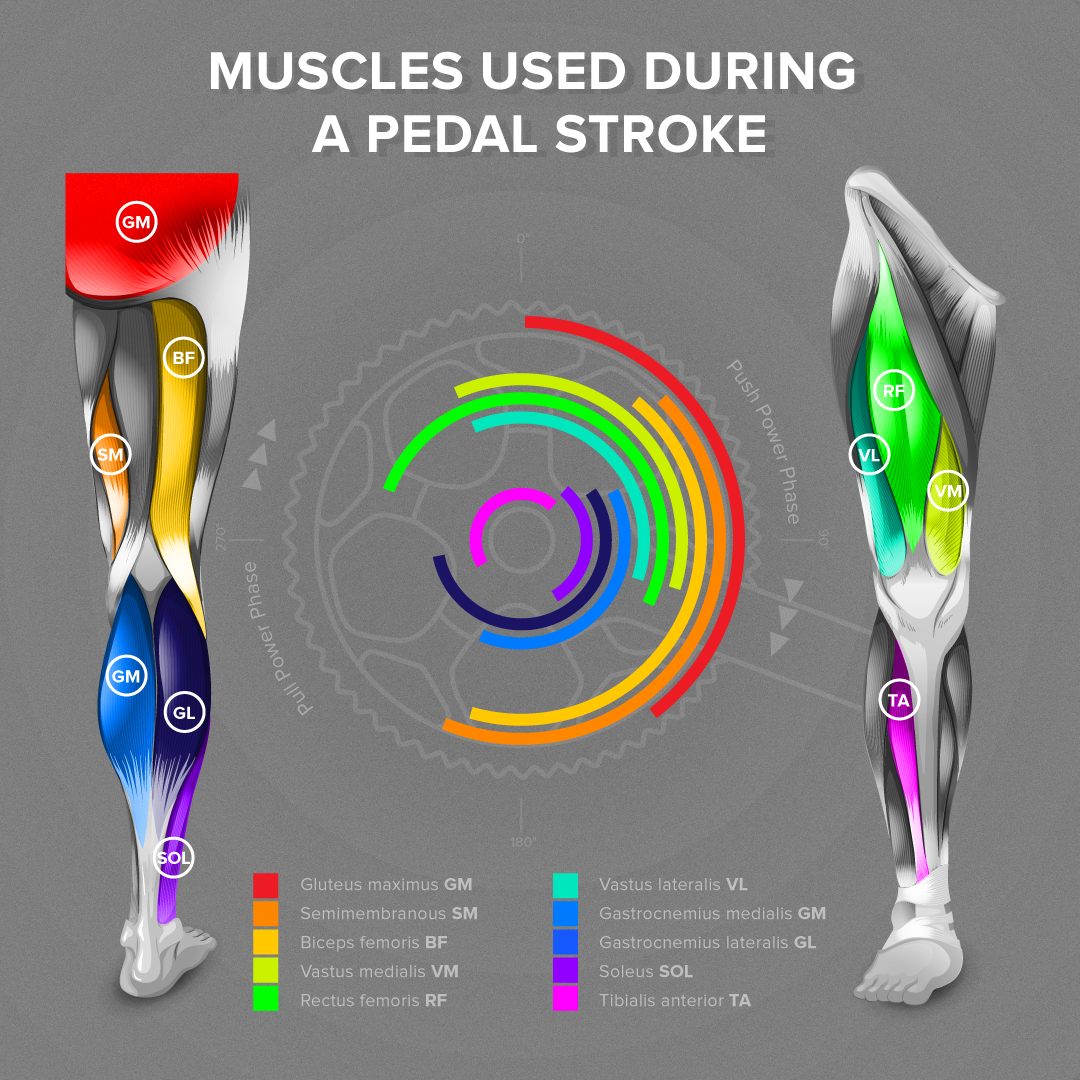
The Gluteal (aka your ass!) Muscles = Involved in both running and cycling The glutes drive cycling. Although your thighs contract in order to rotate the pedals, the force of the rotation comes from the muscles of your backside. When you run, your glutes are an important part of powering your stride to support the length and speed of your gait, but both are primarily the function of the legs. Runners and cyclists should train and stretch the hip flexors to support development of the glutes.
The Calves = Involved in running more than cycling
Runners rely on their calves considerably more than cyclists — they are a significant source of running momentum. The calves flex the ankles and the knees without the support of pedals or the thigh muscles, and assist in the runner’s propulsion. In cycling, the calves offer assistance with pushing the pedal by directing the foot as needed but cleat position will influence this.
The Arms = Involved in running more than cycling . Arms are surprisingly important in running (try running with no arm movement!)….each bicep pulls the arm back in opposition to the raising quadricep, before the tricep pulls the arm forward to help propel you forward as the hamstring completes the stride. As a cyclist, your arms do considerably less work than when you run but still some work in fact there is quite a lot of blood flow to the arms and deltoids whilst cycling.

IS CARDIOVASCULAR FITNESS DIFFERENT
CYCLING VS RUNNING?
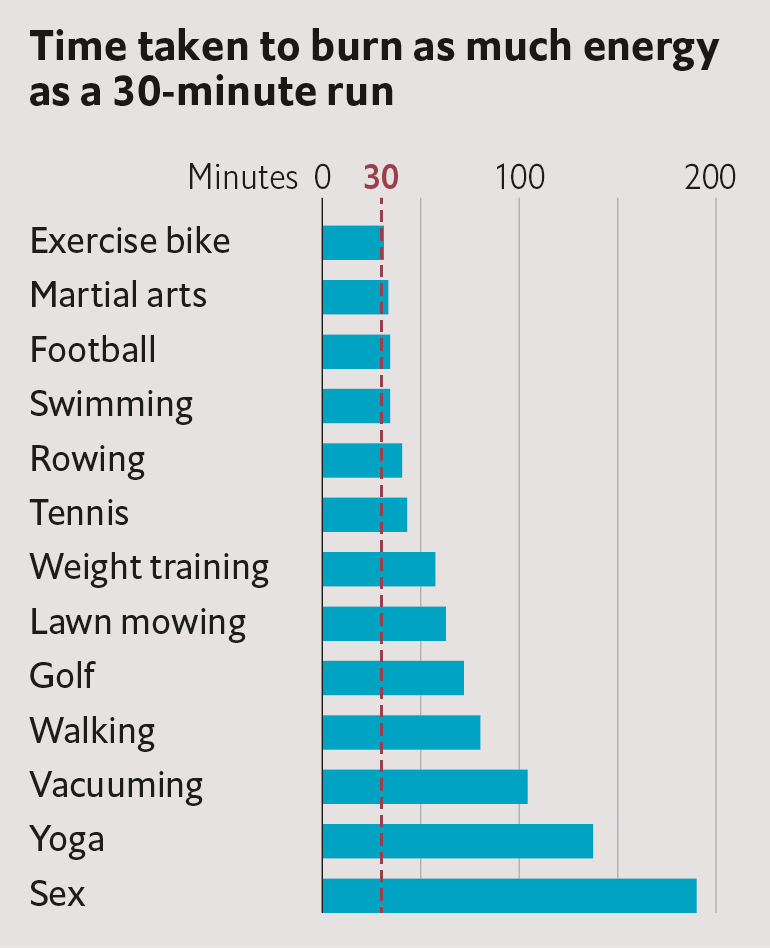
Both running and cycling are superb workouts. In general running provokes a higher heart rate and physiological load because you are carrying your full body weight….but it depends strongly on pace.
By comparing physiological variables such as maximal oxygen consumption (VO2max), anaerobic threshold (AT), heart rate, economy or delta efficiency measured in cycling and running in triathletes, runners or cyclists the majority of studies indicate that runners achieve a higher VO2max on treadmill whereas cyclists can achieve a VO2max value in cycle ergometry similar to that in treadmill.
VO2max is specific to the exercise modality, the muscles adapt specifically to a given exercise task over a period of time, resulting in an improvement in submaximal physiological variables such as the ventilatory threshold, in some cases without a change in VO2max. Interesting in triathletes, there is generally no difference in VO2max measured in cycle ergometry and treadmill running.
If you want to compare activities there are back of the envelope type of comparisons (ie on average); for example, training peaks gives running top spot with 800cal/hr but cycling almost as good (750cal/hr) and swimming (500/hr) and walking 250cal/hr.

If you want to go into this in much more detail there is an excellent review by Billet and here is the free text pdf (LINK).
However on a population level it might be that vacuuming burns more calories than running! Why? because so many people vacuum their house than run outside!

OK WHAT ABOUT ENERGY EFFICIENCY
RUNNING VS WALKING VS CYCLING?
This all reminds me of the chart of how fast to walk or run to be most efficient. Basically, the calories per mile is fixed by physics so *no matter how fast you go* the calories per mile is basically the same in running and cycling….assuming you are not freewheeling 😉
BUT it’s slightly different to walking, where the energy required to walk a given distance generally goes up with pace. This means that at slow speeds, it costs less energy to walk than run, but as you go faster it becomes easier to run. When people are put on a treadmill and the speed gradually increased, they will naturally transition from walking to running. This transition is called the Preferred Transition Speed (PTS)[6].
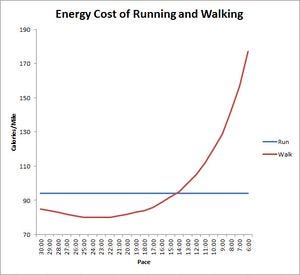

However, calories per hour are strongly linked with pace (or intensity)…and of course so is fatigue….so if you want to burn a lot of calories you should go faster but if you want to sustain it, then go slower (duh) and if you combine the two to maxmise “fat burn” in aerobic exercise then although the highest pace burns highest total calories (per min), medium pace burns highest % fat, actually a low pace *for a long time* burns most total calories and total fat calories.

The take away is this: if you have limited time, go as fast as possible (within that time target) to burn most calories. if you have unlimited time, then go at whatever pace you wish.
ARE RUNNING DYNAMICS AFFECTED BY CYCLING?
Some clever people have compared running dynamics running alone vs running after a bike. Here is one example (LINK). In this study the running distance was significantly lower after biking; with a decrease in stride length of 0.1 m (p = 0.00) and higher %SmO2 (p = 0.00). However no effects were reported in vertical oscillation, ground contact time, running cadence, and average heart rate.
Numerous other studies have investigated the effects of the cycle-run transition on subsequent running adaptation in triathletes (Bernard et al., 2003; Hue et al., 1998; Millet and Vleck, 2000). Compared with an isolated run (the first few minutes of) triathlon running have been reported to induce:
increases in oxygen uptake (VO2) (Bernard et al. , 2003; Hue et al., 1998; Millet and Vleck, 2000; Vercruyssen et al., 2002)
alterations in ventilatory efficiency (VE) (Bernard et al., 2003; Hue et al., 1998; Millet and Vleck, 2000; Vercruyssen et al., 2002)
changes in muscle blood flow (Millet and Vleck, 2000; Bernard et al., 2003).
The increase in energy cost varies from 1.6% to 11.6% (Millet and Vleck, 2000) and is a reflection of triathlete ability level, with superior triathletes performing more economically (Miura et al., 1999).
These physiological changes may be related to cycling induced glycogen depletion, thermoregulation and dehydration (Hausswirth and Lehénaff, 2001; Hue et al., 1998; Lepers et al., 2001a; Millet and Vleck, 2000), or to alterations in biomechanical variables such as stride length (Gottschall and Palmer, 2002; Hue et al., 1998; Vercruyssen et al., 2002).
CADENCE AND PACE INFLUENCES
We are going to look at this soon, but most economical pedalling cadence is between 50-70 rpm at low power and 80–100 rpm (Brisswalter et al., 2000; Chavarren and Calbet, 1999), road cyclists and triathletes typically prefer to use pedalling rates of 85–95 rpm during prolonged exercise at high intensities (Brisswalter et al., 2000; Lucía et al., 2001; Marsh et al., 2000a). Higher cadence is metabolically costly but reduces exhausting effects of high torque ie minimise recruitment of type II muscle fibres and optimise the use of the more efficient fatigue resistant type I fibres (Ahlquist et al., 1992).
Bernard et al. (2003) investigated the effect of cycling cadence (60, 80, 100 rpm) on a subsequent running performance in triathletes (20 minutes cycling + 3000m run). There was no significant effect of cycling cadence on running performance, despite some changes in running strategies and metabolic contributions. However, the subjects were able to sustain a higher fraction of VO2max during the 60 rpm run session — that is, 92% — than the 80 and 100 rpm run sessions — 84% and 87% of VO2max, respectively.
Gottschall and Palmer (2002) investigated the effect of cycling cadence (preferred cadence (PF), PF+20% and PF-20%) on subsequent running performance in triathletes (30 minutes cycling + 3200m run). After fast cadence cycling, run times averaged nearly a minute faster than after the slower cadence conditions. Stride frequency after the fast cadence condition was significantly higher than after the slower cadences.
Tew et al. (2005) examined the effects of different pedalling cadences on the performance of a subsequent 10km treadmill run. A significant effect of prior cycling exercise was found on 10km running time without any cadence effect but during the first 500 m of the run, running velocity was significantly higher after cycling at the preferred and fast cadences than after the slow cadence (p < 0.05). Furthermore, the slow cadence condition was associated with a significantly lower HR (p = 0.012) and VE (p = 0.026) during cycling than in the fast cadence condition.
WILL MY RUNNING SUFFER IF I CYCLE?
Isolated run vs. runs performed after cycling
Previous studies (e.g. Bentley et al., 2002; Bernard et al., 2003; Hue et al., 1998) support the finding that prior cycling has a negative affect on subsequent running performance. Bernard et al. (2003) observed, during a simulated triathlon event (20 minutes cycling, 3km run), a significant difference between 3km post-cycling run performance and isolated 3km run performance. The cycling event caused an increase in mean 3km race time (631 s) and a decrease in mean running velocity (17. 2 km•hr-1) compared with the isolated run (583 s and 18.5 km•hr-1). Hue et al. (1998) also showed that a 10km run following 40km of cycling had higher oxygen cost than a 10km run alone performed at the same speed.
The alteration in running performance after cycling could be related to the high metabolic load sustained by subjects at the end of cycling characterised by an increase in blood lactate concentration (7.45–10.76 mmol•l-1) associated with a high percentage of VO2max (77–83%) and HRmax (89–93%). These physiological changes may lead to cycling induced glycogen depletion, hyperthermia and dehydration (Hue et al., 1998; Lepers et al., 2001a) or alterations in stride length in the subsequent run, generally related to leg muscle fatigue (Gottschall and Palmer, 2002; Hue et al., 1998; Vercruyssen et al., 2002).
SUMMARY
OK so far, what we have learned is all forms are endurance exercise are beneficial. Compared to no running and no cycling then any running and any cycling is a no brainer!
When you try and combine activities, you will adapt with time. Initially running AND cycling will be a struggle. Compared to cycling on its own, adding running might slightly reduce your raw cycling ability. Similarly compared to running on its own, adding cycling might have a negative impact….BUT how much more is that reduction compared with reducing training in one area and adding a competing new one? I cannot answer that.
In the longer term, your body will adapt and these differences will minimize from say 20% decline in specialist performance to 10%-5% or less. If you can find the time to double or triple train using “brick sessions” you will probably benefit your overall health. In fact all these effects are fully reversible if you want to switch back to solo single activity in the future. However I want to mention one last area, which is bone health……
DON’T FORGET BONE HEALTH!
Bone health is vitally important especially as you age. Bones experience huge forces during movement. When a triple jumper’s heel hits the ground, the force is around 15 times their body weight — or the weight of a small car. In fact, because muscles normally attach close to joints, muscular forces are even greater than these impact forces and experience more than five times body weight even during walking.
Bone’s response to these forces varies along its length. Bones also change in shape. The shin bone shaft starts as a circular tube, but gets wider from front to back as we grow and start to move until it forms a tear-drop shape. Near the joints, bones get bigger and more dense, whereas bone shafts tend to get bigger and thicker with little change in bone density. But if we start to load our bones less, they waste away and these effects are no less dramatic. Astronauts lose up to 1% of their leg bone mass per month when in in space, while people who suffer a spinal cord injury lose up to half of their shin bone mass.
These forces squash, twist and bend bones. The shin bone briefly becomes nearly a millimetre shorter as your foot hits the ground when running! The bone senses these small changes, and can grow dramatically — in the months after starting exercise — in order to reduce the risk of breaking. For example, the racket arm bones of tennis players can be 20% wider and contain 40% more bone mineral than their other arm, while sprint runners have up to a third more bone in their shin bone than people who don’t exercise.
But not all exercise gives us big, strong bones only impact exercise and gravity defying exercise. Swimmers and cyclists have healthy hearts, lungs and muscles but their bones are not much different from people who do not exercise.
Cyclists who maintain a really low weight are particularly at risk of low bone mineral density, osteopenia and osteoporosis. A bone only needs to experience about a tenth of the amount of force needed to break it in order to be stimulated enough to create increased bone density. So an added benefit of running or even weight training is to prevent a deterioration in bone health in cyclists. That might be a good reason to run after all!
REFERENCES/CITATIONS
Ahlquist L.E., Bassett D.R., Sufit R., Nagle F.J., Thomas D.P. (1992) The effect of pedalling frequency on glycogen depletion rates in type 1 and type 2 quadriceps muscle fibres during submaximal cycling exercise. European Journal of Applied Physiology 65, 360–364.
Atkinson G., Davison R., Jeukendrup A., Passfield L. (2003) Science and cycling: current knowledge and future directions for research. Journal of Sports Sciences 21, 767–787.
Beelen A., Sargeant A.J. (1993) Effect of prior exercise at different pedalling frequencies on maximal power in humans. European Journal of Applied Physiology 66, 102–107.
Bentley D.J., Millet G.P., Vleck V.E., McNaughton L.R. (2002) Specific aspects of contemporary triathlon — Implications for physical analysis and performance. Sports Medicine 32, 345–359.
Bernard T., Vercruyssen F., Grego F., Hausswirth C., Lepers R., Vallier J.M., Brisswalter J. (2003) Effect of cycling cadence on subsequent 3km running performance in well trained triathletes. British Journal of Sports Medicine 37, 154–159.
Borg G. (1973) Perceived exertion — a note on history and methods. Medicine and Science in Sports and Exercise 5, 90–93.
Brisswalter J., Hausswirth C., Smith D., Vercruyssen F., Vallier J.M. (2000) Energetically optimal cadence vs. freely chosen cadence during cycling: effect of exercise duration. International Journal of Sports Medicine 21, 60–64.
Chavarren J, , Calbet J (1999) Cycling efficiency and pedalling frequency in road cyclists. 80, 555–563.
Deschenes M.R., Kraemer W.J., McCoy R.W., Volek J.S., Turner B.M., Weinlein J.C. (2000) Muscle recruitment patterns regulate physiological responses during exercise of the same intensity. American Journal of Physiology, Regulatory Integrative Complimentary Physiology 279, 2229–2236.
Gotshall R.W., Bauer T.A., Fahrner S.L. (1996) Cycling cadence alters exercise hemodynamics. International Journal of Sports Medicine 17, 17–21.
Gottschall J.S., Palmer B.M. (2002) The acute effects of prior cycling cadence on running performance and kinematics. Medicine and Science in Sports and Exercise 34, 1518–1522.
Gurfinkel V.S., Levik Y.S., Kazennikov O.V., Selionov V.A. (1998) Locomotor-like movements evoked by leg muscle vibration in humans. European Journal of Neuroscience 10, 1608–1612.
Hausswirth C., Lehénaff D. (2001) Physiological demands of running during long distance runs and triathlons. Sports Medicine 31, 679–689.
Howley E.T., Basset D.R., Welch H.G. (1995) Criteria for maximal oxygen uptake: review and commentary. Medicine and Science in Sports and Exercise 27, 1292–1301.
Hue O., Gallais D.L., Chollet D., Boussana A., Prefaut C. (1998) The influence of prior cycling on biomechanical and cardiorespiratory response profiles during running in triathletes. European Journal of Applied Physiology 77, 98–105.
Jameson C, , Ring C. (2000) Contributions of local and central sensations to the perception of exertion during cycling: Effects of work rate and cadence. 18, 291–298.
Jones A.M., Doust J.H. (1996) A 1% treadmill grade most accurately reflects the energy cost of outdoor running. Journal of Sports Sciences 14, 321–327.
Lepers R., Millet G.Y., Maffiuletti N.A. (2001b) Effect of cycling cadence on contractile and neural properties of knee extensors. MMedicine and Science in Sports and Exercise 33, 1882–1888.
Lepers R., Millet G.Y., Maffiuletti N.A., Hausswirth C., Brisswalter J. (2001a) Effect of pedalling rates on physiological response during endurance cycling. European Journal of Applied Physiology 85, 392–395.
Lucía A., Hoyos J., Chicharro J.L. (2001) Preferred pedalling cadence in professional cycling. Medicine and Science in Sports and Exercise 33, 1361–1366.
Marsh A.P., Martin P.E., Foley K.O. (2000a) Effect of cadence, cycling experience, and aerobic power on delta efficiency during cycling. Medicine and Science in Sports and Exercise 32, 1630–1634.
Marsh A.P., Martin P.E., Sanderson D.J. (2000b) Is a joint moment-based cost function associated with preferred cycling cadence?. Journal of Biomechanics 33, 173–180.
Millet G.P., Vleck V.E. (2000) Physiological and biomechanical adaptations to the cycle to run transition in Olympic triathlon: review and practical recommendations for training. British Journal of Sports Medicine 34, 384–390.
Miura H, , Kitagawa K, , Ishiko T. (1997) Economy during a simulated laboratory test triathlon is highly related to Olympic distance triathlon. 18, 276–280.
Miura H., Kitagawa K., Ishiko T. (1999) Characteristic feature of oxygen cost at simulated laboratory triathlon test in trained triathletes. Journal of Sports Medicine and Physical Fitness 39, 101–106.
Neptune R.R., Hull M.L. (1999) A theoretical analysis of preferred pedalling rate selection in endurance cycling. Journal of Biomechanics 32, 409–415.
Pringle J.S.M., Doust J.H., Carter H., Tolfrey K., Jones A.M. (2003) Effect of pedal rate on primary and slow component oxygen uptake responses during heavy cycle exercise. 94, 1501–1507.
Rowland T., Lisowski R. (2001) Hemodynamic responses to increasing cycling cadence in 11-year old boys: role of the skeletal muscle pump. International Journal of Sports Medicine 22, 405–409.
Sarre G., Lepers R., Maffiuletti N., Millet G., Martin A. (2003) Influence of cycling cadence on neuromuscular activity of the knee extensors in humans. European Journal of Applied Physiology 88, 476–479.
Takaishi T, , Yasuda Y, , Ono T, , Moritani T. (1996) Optimal pedalling rates estimated from neuromuscular fatigue for cyclists. 28, 1492–1497.
Vercruyssen F., Brisswalter J., Hausswirth C., Bernard T., Bernard O., Vallier J.M. (2002) Influence of cycling cadence on subsequent running performance in triathlon. Medicine and Science in Sports and Exercise 3, 530–536.
